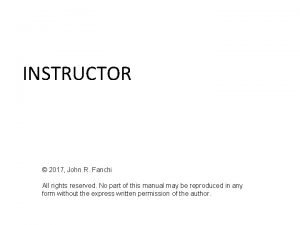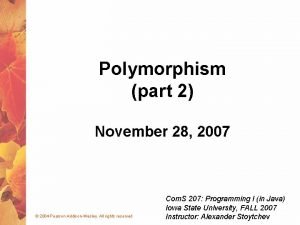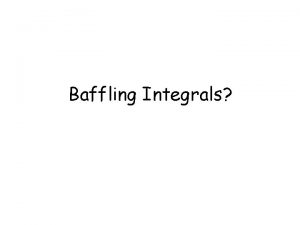5 Integrals Copyright Cengage Learning All rights reserved










![The Definite Integral Note 4: Although we have defined by dividing [a, b] into The Definite Integral Note 4: Although we have defined by dividing [a, b] into](https://slidetodoc.com/presentation_image/9971c3cce70e39ce9b42aeba0087a7b4/image-11.jpg)


![Example 1 Express as an integral on the interval [0, ]. Solution: Comparing the Example 1 Express as an integral on the interval [0, ]. Solution: Comparing the](https://slidetodoc.com/presentation_image/9971c3cce70e39ce9b42aeba0087a7b4/image-14.jpg)























- Slides: 37

5 Integrals Copyright © Cengage Learning. All rights reserved.

5. 2 The Definite Integral Copyright © Cengage Learning. All rights reserved.

The Definite Integral We have seen that a limit of the form arises when we compute an area. We also saw that it arises when we try to find the distance traveled by an object. It turns out that this same type of limit occurs in a wide variety of situations even when f is not necessarily a positive function. 3

The Definite Integral Note 1: The symbol was introduced by Leibniz and is called an integral sign. It is an elongated S and was chosen because an integral is a limit of sums. 4

The Definite Integral In the notation f (x) is called the integrand a and b are called the limits of integration; a is the lower limit and b is the upper limit. For now, the symbol dx has no meaning by itself; is all one symbol. The dx simply indicates that the independent variable is x. The procedure of calculating an integral is called integration. 5

The Definite Integral Note 2: The definite integral is a number; it does not depend on x. In fact, we could use any letter in place of x without changing the value of the integral: Note 3: The sum that occurs in Definition 2 is called a Riemann sum after the German mathematician Bernhard Riemann (1826– 1866). 6

The Definite Integral So Definition 2 says that the definite integral of an integrable function can be approximated to within any desired degree of accuracy by a Riemann sum. We know that if f happens to be positive, then the Riemann sum can be interpreted as a sum of areas of approximating rectangles (see Figure 1). If f (x) 0, the Riemann sum f (xi*) x is the sum of areas of rectangles. Figure 1 7

The Definite Integral We see that the definite integral can be interpreted as the area under the curve y = f (x) from a to b. (See Figure 2. ) If f (x) 0, the integral is the area under the curve y = f (x) from a to b. Figure 2 8

The Definite Integral If f takes on both positive and negative values, as in Figure 3, then the Riemann sum is the sum of the areas of the rectangles that lie above the x-axis and the negatives of the areas of the rectangles that lie below the x-axis (the areas of the blue rectangles minus the areas of the gold rectangles). f (xi*) x is an approximation to the net area. Figure 3 9

The Definite Integral When we take the limit of such Riemann sums, we get the situation illustrated in Figure 4. A definite integral can be interpreted as a net area, that is, a difference of areas: where A 1 is the area of the region above the x-axis and below the graph of f, and A 2 is the area of the region below the x-axis and above the graph of f. is the net area. Figure 4 10
![The Definite Integral Note 4 Although we have defined by dividing a b into The Definite Integral Note 4: Although we have defined by dividing [a, b] into](https://slidetodoc.com/presentation_image/9971c3cce70e39ce9b42aeba0087a7b4/image-11.jpg)
The Definite Integral Note 4: Although we have defined by dividing [a, b] into subintervals of equal width, there are situations in which it is advantageous to work with subintervals of unequal width. If the subinterval widths are x 1, x 2, . . . , xn, we have to ensure that all these widths approach 0 in the limiting process. This happens if the largest width, max xi, approaches 0. So in this case the definition of a definite integral becomes 11

The Definite Integral Note 5: We have defined the definite integral for an integrable function, but not all functions are integrable. The following theorem shows that the most commonly occurring functions are in fact integrable. The theorem is proved in more advanced courses. If f is integrable on [a, b], then the limit in Definition 2 exists and gives the same value no matter how we choose the sample points. 12

The Definite Integral To simplify the calculation of the integral we often take the sample points to be right endpoints. Then = xi and the definition of an integral simplifies as follows. 13
![Example 1 Express as an integral on the interval 0 Solution Comparing the Example 1 Express as an integral on the interval [0, ]. Solution: Comparing the](https://slidetodoc.com/presentation_image/9971c3cce70e39ce9b42aeba0087a7b4/image-14.jpg)
Example 1 Express as an integral on the interval [0, ]. Solution: Comparing the given limit with the limit in Theorem 4, we see that they will be identical if we choose f (x) = x 3 + x sin x. We are given that a = 0 and b = . Therefore, by Theorem 4, we have 14

The Definite Integral When Leibniz chose the notation for an integral, he chose the ingredients as reminders of the limiting process. In general, when we write we replace lim by , by x, and x by dx. 15

Evaluating Integrals 16

Evaluating Integrals When we use a limit to evaluate a definite integral, we need to know how to work with sums. The following three equations give formulas for sums of powers of positive integers. 17

Evaluating Integrals The remaining formulas are simple rules for working with sigma notation: 18

Example 2 (a) Evaluate the Riemann sum for f (x) = x 3 – 6 x, taking the sample points to be right endpoints and a = 0, b = 3, and n = 6. (b) Evaluate Solution: (a) With n = 6 the interval width is and the right endpoints are x 1 = 0. 5, x 2 = 1. 0 , x 3 = 1. 5, x 4 = 2. 0, x 5 = 2. 5, and x 6 = 3. 0. 19

Example 2 – Solution cont’d So the Riemann sum is R 6 = f (xi) x = f (0. 5) x + f (1. 0) x + f (1. 5) x + f (2. 0) x + f (2. 5) x + f (3. 0) x = (– 2. 875 – 5. 625 – 4 + 0. 625 + 9) = – 3. 9375 20

Example 2 – Solution cont’d Notice that f is not a positive function and so the Riemann sum does not represent a sum of areas of rectangles. But it does represent the sum of the areas of the blue rectangles (above the x-axis) minus the sum of the areas of the gold rectangles (below the x-axis) in Figure 5 21

Example 2 – Solution cont’d (b) With n subintervals we have So x 0 = 0, x 1 = 3/n, x 2 = 6/n, x 3 = 9/n, and, in general, xi = 3 i/n. Since we are using right endpoints, we can use Theorem 4: 22

Example 2 – Solution cont’d (Equation 9 with c = 3/n) (Equations 11 and 9) (Equations 7 and 5) 23

Example 2 – Solution cont’d 24

Example 2 – Solution cont’d This integral can’t be interpreted as an area because f takes on both positive and negative values. But it can be interpreted as the difference of areas A 1 – A 2, where A 1 and A 2 are shown in Figure 6 25

Example 2 – Solution cont’d Figure 7 illustrates the calculation by showing the positive and negative terms in the right Riemann sum Rn for n = 40. R 40 – 6. 3998 Figure 7 26

Example 2 – Solution cont’d The values in the table show the Riemann sums approaching the exact value of the integral, – 6. 75, as n 27

Solve this one 28

Answer 29

Properties of the Definite Integral 30

Properties of the Definite Integral When we defined the definite integral implicitly assumed that a < b. , we But the definition as a limit of Riemann sums makes sense even if a > b. Notice that if we reverse a and b, then x changes from (b – a)/n to (a – b)/n. Therefore 31

Properties of the Definite Integral If a = b, then x = 0 and so We now develop some basic properties of integrals that will help us to evaluate integrals in a simple manner. We assume that f and g are continuous functions. 32

Properties of the Definite Integral The next property tells us how to combine integrals of the same function over adjacent intervals. 33

Solve Me 34

Answer 35

Solve Me 36

Answer 37
 Copyright 2015 all rights reserved
Copyright 2015 all rights reserved Copyright 2015 all rights reserved
Copyright 2015 all rights reserved Dell all rights reserved copyright 2009
Dell all rights reserved copyright 2009 Copyright © 2018 all rights reserved
Copyright © 2018 all rights reserved Copyright cengage learning. powered by cognero
Copyright cengage learning. powered by cognero All rights reserved example
All rights reserved example All rights reserved sentence
All rights reserved sentence Creative commons vs all rights reserved
Creative commons vs all rights reserved Confidential all rights reserved
Confidential all rights reserved All rights reserved example
All rights reserved example 2012 pearson education inc
2012 pearson education inc Microsoft corporation. all rights reserved.
Microsoft corporation. all rights reserved. Microsoft corporation. all rights reserved
Microsoft corporation. all rights reserved Microsoft corporation. all rights reserved.
Microsoft corporation. all rights reserved. Pearson education inc. all rights reserved
Pearson education inc. all rights reserved Warning all rights reserved
Warning all rights reserved All rights reserved c
All rights reserved c All rights reserved formula
All rights reserved formula Warning all rights reserved
Warning all rights reserved Confidential all rights reserved
Confidential all rights reserved Microsoft corporation. all rights reserved
Microsoft corporation. all rights reserved Pearson education inc. all rights reserved
Pearson education inc. all rights reserved 2017 all rights reserved
2017 all rights reserved Copyright 2010 pearson education inc
Copyright 2010 pearson education inc 2010 pearson education inc
2010 pearson education inc Confidential all rights reserved
Confidential all rights reserved Airbus deutschland gmbh
Airbus deutschland gmbh R rights reserved
R rights reserved Rights reserved
Rights reserved 2009 delmar cengage learning
2009 delmar cengage learning Medical terminology chapter 5 learning exercises answers
Medical terminology chapter 5 learning exercises answers Cengage learning heart diagram
Cengage learning heart diagram South-western cengage learning
South-western cengage learning Chapter 13 medical math
Chapter 13 medical math 2009 delmar cengage learning
2009 delmar cengage learning Cengage learning heart diagram
Cengage learning heart diagram Challenge word building medical terminology
Challenge word building medical terminology Cengage learning australia
Cengage learning australia





























































